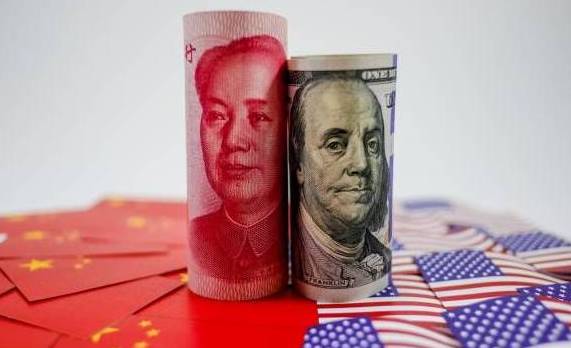India's $Trillions Pullback: Two Decades in Reverse?
As the wheels of fortune seem to pivot sharply in the realm of global finance, China stands at a crossroads energized by a capital influx, both domestic and international. This vibrant surge in the Chinese market has drawn eyes across the continents, casting doubts on previously stable financial landscapes, particularly those of emerging economies like India, which now face unprecedented challenges.
Initially, it was reasonable to surmise that the awakening of Chinese capital markets would lead to losses primarily for American investors. However, in a perplexing twist, as the United States appears unfazed by this development, it is India that finds itself unexpectedly vulnerable. Recent reports describe a staggering decline in Indian stocks, particularly the Nifty 50 index, which plunged nearly 4.45 percent amid an extensive sell-off amounting to an eye-watering $4.5 billion in just one week. Such drastic fluctuations have sparked debates about whether India, once a sought-after beneficiary in the Sino-American tussle, is now shifting into the role of a victim.
A Conundrum for India
The sell-off signals a troubling trend for India, illustrating the precarious nature of its reliance on foreign capital. Contrary to the notion that India's economic ascent has stemmed from solid fundamental successes, a significant factor often cited is its position in the rivalry between China and the U.S. The paradox lies in India's potential; even though it possesses a massive consumer market akin to China, its realities are less promising.
India's economic narrative in recent years has been dominated by foreign investments, which peaked as international corporations flocked to establish operations, drawn in by the allure of an expanding market. Tech giants like Apple have contributed to this trend, while foreign investors bolstered the equity markets, giving rise to an unusual phenomenon: ten consecutive years of soaring stock prices, culminating in a formidable $4 trillion market capitalization. Yet, in stark contrast, India’s fundamental economic situation has remained largely stagnant, echoing concerns about a potential outflow of capital under current circumstances as the Chinese market revitalizes.
The gleaming accolades that hailed India's supposed arrival as an economic powerhouse are now facing scrutiny. With Prime Minister Modi's strategic alignment shifting between the United States and emerging alliances like BRICS, international perceptions of India are altering more dramatically than anticipated; rather than a new leader, India risks being relegated to the sidelines of global finance.
The current status poses a dual challenge for India, caught between the ambitions of attracting foreign investment and the consequences of a shifting global narrative. The recent U.S.-China rivalry appears to be rewriting rules, where potential advantages previously enjoyed by India are dissipating. International capital viewing India as a viable partner must now grapple with unforeseen risks, turning once-promising opportunities into precarious positions.
Having historically focused on safeguarding its market against foreign exploitation, India is now facing a pivot in strategies. The sudden dread is no longer merely about safeguarding against foreign capital 'harvesting' but rather accommodating those who might seize opportunities presented by undervalued assets.

The sentiment across global finance appears to reveal a newfound favor towards Chinese assets, offering greater value for investment than much-visited markets like India’s or the U.S. stock exchanges, where volatility reigns supreme. Reports from major financial institutions like Morgan Stanley, Goldman Sachs, and HSBC reflect an invigorated interest in cultivating exposure to Chinese equities, demonstrating a burgeoning trend towards valuing China as a more strategic and lucrative avenue.
China: A New Beacon for International Capital?
The current shift in capital influx towards China raises essential questions regarding the implications for the global financial landscape, particularly in light of anticipated growth in domestic consumption and market strategies. Observers might mistake these developments as mere reactions to attract consumption and innovate economic models. However, a more nuanced understanding reveals the broader context of Western apprehensions over stagnant and frothy financial markets within their shores, thus seeking healthier investment locales.
The sheer scale of China's potential as a consuming nation juxtaposed against the diminished attractiveness of Western markets paints a new reality. Critics often argue against the maturity of China’s financial landscape compared to its Western counterparts, yet this typifies a misunderstanding of China’s developmental focus. Historically concentrated on industrial growth to satiate the needs of an expansive workforce and enhance living standards, China stands poised at the precipice of a new economic chapter.
As the U.S. Federal Reserve’s policies begin to shift from tightening to potential easing, the implications for asset-rich but risk-averse investors become clearer. The waning of apprehensions surrounding foreign capital influences opens avenues for China’s capital markets to regain momentum, further attracting international attention.
The evolving financial landscape suggests a transformational arc for China, tilting away from isolationist tendencies toward consolidating its role as a central player in global finance. The projections indicate that the burgeoning interest in Chinese markets is not merely opportunistic; it signifies a recognition that global finance necessitates coalescence over competition.
As industries worldwide align towards benefiting from China’s vast infrastructure and market potential, parallels with the ongoing shifts signify a new era of cooperation. Anticipating future stakes in international finance, the markets hint towards an emerging consensus that involves collective participation in the prosperity of China's promising markets.
In conclusion, this allocation of international capital towards China signals more than a momentary surge; it ignites a broader rethinking of economic engagement strategies and interdependencies. India’s preceding rise as an alternative to China risk being overshadowed; it depends on how deftly it can navigate the current tides against risks from its inherent vulnerabilities. The ramifications of this financial evolution are only beginning to unfold, setting a stage for a potentially reshaped global economic order that aligns more closely with China’s plans and capacities.
Leave A Comment